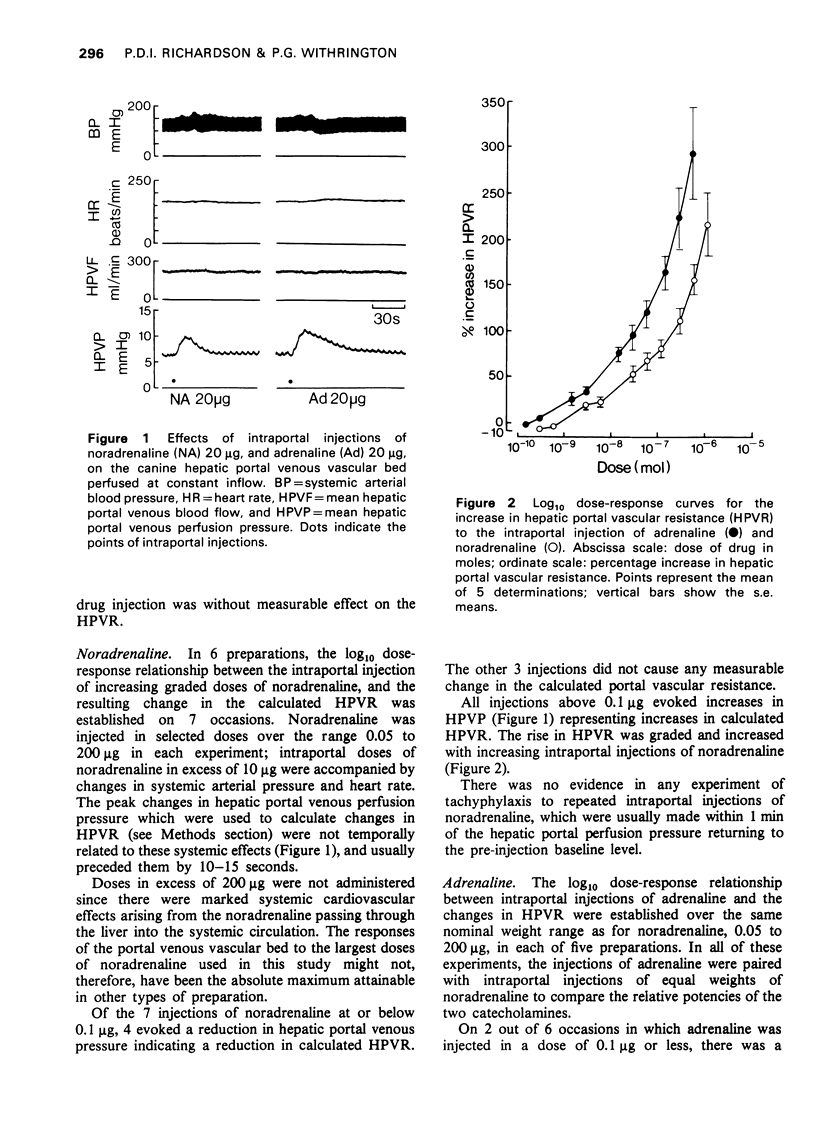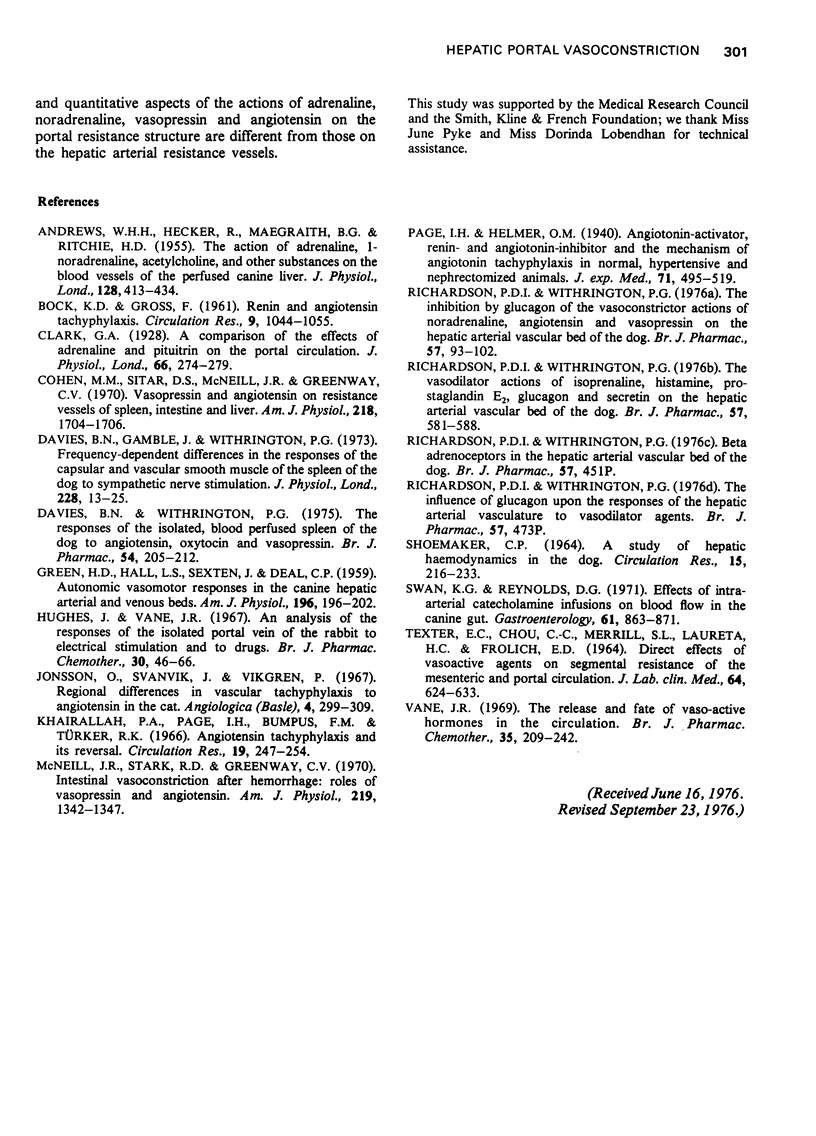Abstract
1 The hepatic portal vein of the anesthetized dog was cannulated and perfused with blood derived from the cannulated superior mesenteric vein. 2 The portal vein was perfused at constant flow, the hepatic portal venous pressure being monitored continuously together with the inferior vena caval pressure. From these measurements, the hepatic portal venous vascular resistance was calculated. 3 Noradrenaline and adrenaline were injected intraportally in graded doses which caused dose-dependent increases in the hepatic portal vascular resistance. At all doses, adrenaline was significantly (P less than 0.05) more potent than noradrenaline. 4 Intraportal injections of vasopressin caused reductions in calculated hepatic portal venous vascular resistance in most experiments; three effects were dose-dependent. 5 No tachyphylaxis to the effects of noradrenaline, adrenaline or vasopressin was observed. 6 Intraportal injections of angiotensin caused dose-dependent increases in calculated hepatic portal vascular resistance up to 5 mug; therafter larger doses caused smaller increases in portal resistance. 7. Repeated intraportal injections of angiotensin revealed the existence of tachyphylaxis in the hapatic portal vascular bed. 8 Intraportal infusions of anagiotensin caused rises in calculated hepatic portal vascular resistance from which there was almost complete 'escape' despite the continued infusions. Infusions of noradrenaline which caused similar rises in calculated portal vascular resistance did not exhibit equivalent degrees of 'escape'. 9 The development of tachyphylaxisx explains the fact that doses of 10 and 20 mug of angiotensin injected after 5 mug doses produced smaller effects. If a much longer time interval was allowed between injections (30 min), the dose-response curve to angiotensin had a sigmoid shape. 10 These findings are discussed with respect to their possible importance in the functional status of the hepatic portal vascular bed in this species.
Full text
PDF








Selected References
These references are in PubMed. This may not be the complete list of references from this article.
- ANDREWS W. H. H., HECKER R., MAEGRAITH B. G., RITCHIE H. D. The action of adrenaline, L-noradrenaline, acetylcholine and other substances on the blood vessels of the perfused canine liver. J Physiol. 1955 Jun 28;128(3):413–434. doi: 10.1113/jphysiol.1955.sp005316. [DOI] [PMC free article] [PubMed] [Google Scholar]
- BOCK K. D., GROSS F. Renin and angiotensin tachyphylaxis. Circ Res. 1961 Sep;9:1044–1050. doi: 10.1161/01.res.9.5.1044. [DOI] [PubMed] [Google Scholar]
- Clark G. A. A comparison of the effects of adrenaline and pituitrin on the portal circulation. J Physiol. 1928 Nov 9;66(3):274–280. doi: 10.1113/jphysiol.1928.sp002526. [DOI] [PMC free article] [PubMed] [Google Scholar]
- Cohen M. M., Sitar D. S., McNeill J. R., Greenway C. V. Vasopressin and angiotensin on resistance vessels of spleen, intestine, and liver. Am J Physiol. 1970 Jun;218(6):1704–1706. doi: 10.1152/ajplegacy.1970.218.6.1704. [DOI] [PubMed] [Google Scholar]
- Davies B. N., Gamble J., Withrington P. G. Frequency-dependent differences in the responses of the capsular and vascular smooth muscle of the spleen of the dog to sympathetic nerve stimulation. J Physiol. 1973 Jan;228(1):13–25. doi: 10.1113/jphysiol.1973.sp010069. [DOI] [PMC free article] [PubMed] [Google Scholar]
- Davies B. N., Withrington P. G. The responses of the isolated, blood-perfused spleen of the dog to angiotensin, oxytocin and vasopressin. Br J Pharmacol. 1975 Jun;54(2):205–212. doi: 10.1111/j.1476-5381.1975.tb06930.x. [DOI] [PMC free article] [PubMed] [Google Scholar]
- GREEN H. D., HALL L. S., SEXTON J., DEAL C. P. Autonomic vasomotor responses in the canine hepatic arterial and venous beds. Am J Physiol. 1959 Jan;196(1):196–202. doi: 10.1152/ajplegacy.1958.196.1.196. [DOI] [PubMed] [Google Scholar]
- Jonsson O., Svanvik J., Vikgren P. Regional differences in vascular tachyphylaxis to angiotensin in the cat. Angiologica. 1967;4(6):299–309. doi: 10.1159/000157714. [DOI] [PubMed] [Google Scholar]
- Khairallah P. A., Page I. H., Bumpus F. M., Türker R. K. Angiotensin tachyphylaxis and its reversal. Circ Res. 1966 Aug;19(2):247–254. doi: 10.1161/01.res.19.2.247. [DOI] [PubMed] [Google Scholar]
- McNeill J. R., Stark R. D., Greenway C. V. Intestinal vasoconstriction after hemorrhage: roles of vasopressin and angiotensin. Am J Physiol. 1970 Nov;219(5):1342–1347. doi: 10.1152/ajplegacy.1970.219.5.1342. [DOI] [PubMed] [Google Scholar]
- Richardson P. D., Withrington P. G. Beta adrenoceptors in the hepatic arterial vascular bed of the dog [proceedings]. Br J Pharmacol. 1976 Jul;57(3):451P–451P. [PMC free article] [PubMed] [Google Scholar]
- Richardson P. D., Withrington P. G. The inhibition by glucagon of the vasoconstrictor actions of noradrenaline, angiotensin and vasopressin on the hepatic arterial vascular bed of the dog. Br J Pharmacol. 1976 May;57(1):93–102. doi: 10.1111/j.1476-5381.1976.tb07659.x. [DOI] [PMC free article] [PubMed] [Google Scholar]
- Richardson P. D., Withrington P. G. The vasodilator actions of isoprenaline, histamine, prostaglandin E2, glucagon and secretin on the hepatic arterial vascular bed of the dog. Br J Pharmacol. 1976 Aug;57(4):581–588. doi: 10.1111/j.1476-5381.1976.tb10388.x. [DOI] [PMC free article] [PubMed] [Google Scholar]
- SHOEMAKER C. P. A STUDY OF HEPATIC HEMODYNAMICS IN THE DOG. Circ Res. 1964 Sep;15:216–233. doi: 10.1161/01.res.15.3.216. [DOI] [PubMed] [Google Scholar]
- Swan K. G., Reynolds D. G. Effects of intraarterial catecholamine infusions on blood flow in the canine gut. Gastroenterology. 1971 Dec;61(6):863–871. [PubMed] [Google Scholar]
- TEXTER E. C., Jr, CHOU C. C., MERRILL S. L., LAURETA H. C., FROHLICH E. D. DIRECT EFFECTS OF VASOACTIVE AGENTS ON SEGMENTAL RESISTANCE OF THE MESENTERIC AND PORTAL CIRCULATION. STUDIES WITH 1-EPINEPHRINE, LEVARTERENOL, ANGIOTENSIN, VASOPRESSIN, ACETYLCHOLINE, METHACHOLINE, HISTAMINE, AND SEROTONIN. J Lab Clin Med. 1964 Oct;64:624–633. [PubMed] [Google Scholar]
- Vane J. R. The release and fate of vaso-active hormones in the circulation. Br J Pharmacol. 1969 Feb;35(2):209–242. doi: 10.1111/j.1476-5381.1969.tb07982.x. [DOI] [PMC free article] [PubMed] [Google Scholar]


